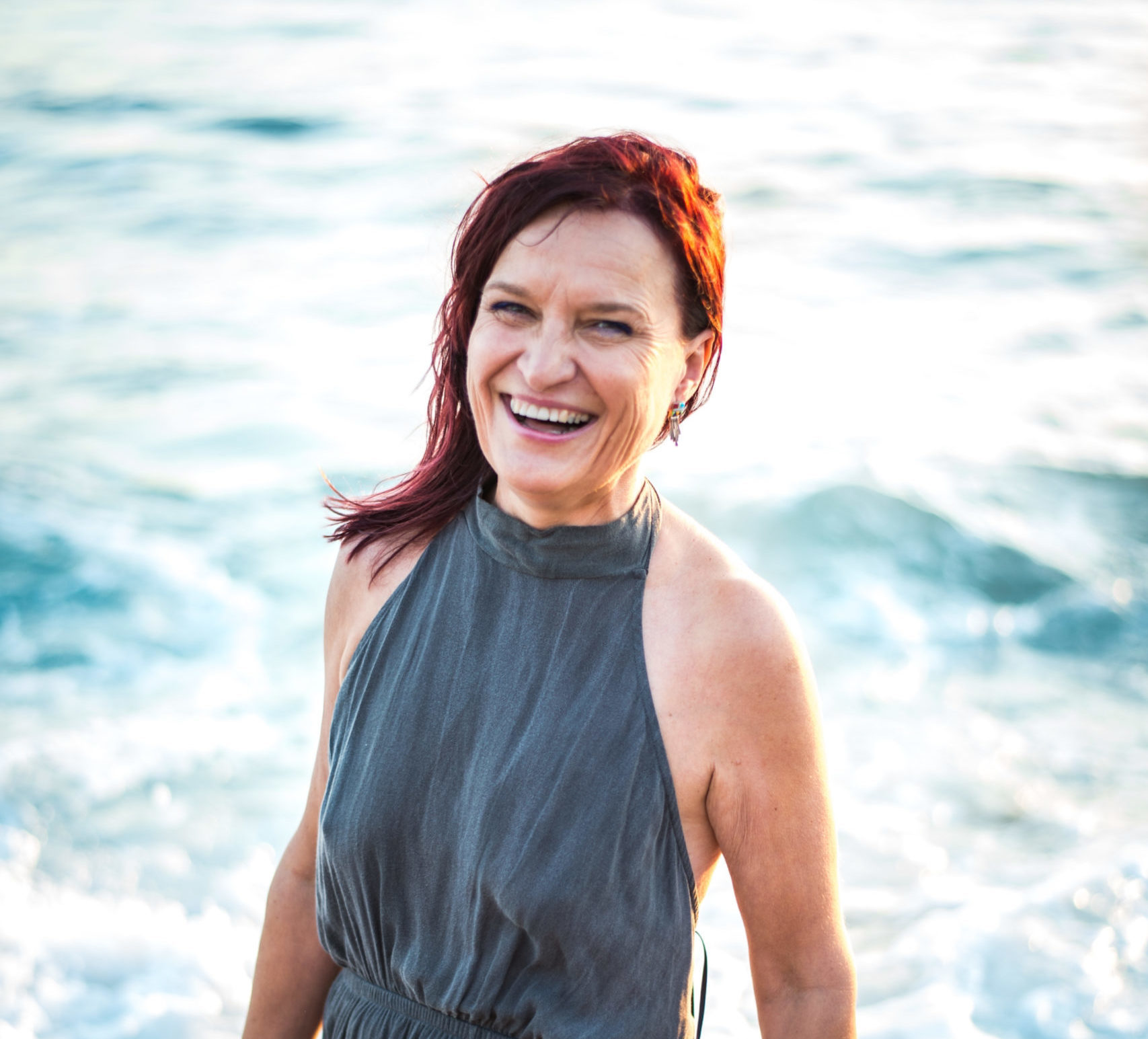For the new impactmania and UCSB program: Human Mind and Migration (HMM), we are featuring migrants who have been contributing cultural, social, and economic wealth and health to their adopted countries. The series Modern-Day Migrants in the Performing Arts explores how opportunities in art and performance can be a catalyst for migration, and how this migratory background has influenced artists’ creative output.
Add your migration story to the HMM program: www.hmm.ucsb.edu.
Tarja Huuskonen, born and raised in Finland, has spent most of her life traveling the world — living both in Europe and in the United States, and most recently making California her new home.
She is the founder and CEO of Action for Results, a consulting company of 25+ years dedicated to advancing Life Sciences innovation by building new capabilities and connections. Her work eventually brought her to the Santa Barbara area, where she suffered a ruptured brain aneurysm in 2016 while kayaking. This was a near-death event that led her to use dance, specifically the Argentine tango, as a means to recovery.
Now a brain health activist and patient voice for other brain aneurysm survivors, Tarja is a national spokesperson and ambassador for the Lisa Foundation, and has started her own non-profit organization, the Harbor of Life, focused on empowering patients in their reentry to life within their local communities. She also sponsors a master’s level gap program at California State University Channel Islands, focused on brain aneurysm early stage product innovation. Tarja is a sought after public speaker and advisor on medical product innovation and corporate and personal transformations.
impactmania speaks with Tarja Huuskonen about her migration experience, what she has learned from designing and heading a global company, and her thoughts on the way dance interacts with the brain.
BY NATALIE GOMEZ
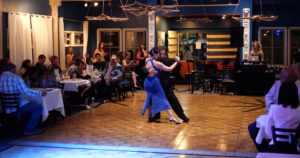
Tarja Huuskonen danced with her tango instructor in the U.S., Michael Serry, at the first ever Harbor of Life fundraiser event in 2019.
Did you have any expectations of what your life would be like when you moved to the United States?
When I first decided to move to the U.S., Finland was on the “eastern European” list in the eyes of many Americans. The immigration process required multiple interviews and background checks — both in Finland and later here — so I got to know the Detroit immigration office quite well. There was tension between the U.S. and the Soviet Union, so that may have played into it, given Finland’s close proximity. I remember being asked several times about my political associations.
On a personal level, I was making a significant move. My grandfather had paved the way many years before me, when Europeans were migrating to the U.S. in search of a better life. He left his family behind to “scout” the U.S., first traveling to Liverpool, England, and then from there by boat to New York City. In fact, I found his name when I went over to Ellis Island to check the immigration records.
It was amazing for me to find the picture of the boat, and his name. I had never actually met my grandfather (he died before I was born), but we had this postcard with an actual photo of him — taken in Telluride, Colorado. He was standing in front of a fake background, and playing his fiddle. With his hat and dark suit, he looked very serious. But he didn’t stay in this country. Instead, he came back to Finland and announced that “America” is not the golden opportunity he thought, and the family should stay put. So no one from our family came to the U.S… Until me.
I wasn’t, of course, headed to work in the mines in Colorado: instead, I had a scholarship to study at Michigan State University. My image of the U.S., before coming here, was that it was a very forward-thinking, liberal, modern country. I had not grown up with TV, so that image was mainly based on what I had read.
There is a funny side story about this. While my childhood Finland didn’t exactly have today’s instant media channels, we got a special series of American movies every summer. John Wayne became one of my favorites when I was 12 years old! So the first night after arriving in the U.S., I was sitting outside and I heard this sound I knew from the summer movies… I was like, “my gosh that’s the same noise as in the John Wayne movies!” But it wasn’t John Wayne riding into town: turns out it was the crickets! (Which of course we don’t have in Finland, but apparently they were part of the sound effects of old Westerns). What a discovery!
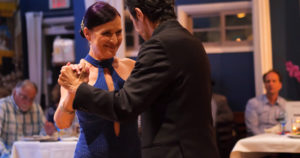
The purpose of the Harbor of Life event was to raise awareness and support for Brain Aneurysm survivors, while celebrating and demonstrating the power of dance in making new connections.
How has your culture been received by the communities you found yourself in? In what ways did you take up the culture from the communities here?
The first community I lived in was a university town. So, perhaps it was more open to differences and people coming from around the world. Incidentally, Michigan was also one of the destinations for the first Finnish immigrants to the U.S. — way before me. There’s actually a college called Suomi College in Michigan. Suomi is Finland in Finnish.
But culturally, I struggled. The U.S. social culture is extremely outwardly, talkative and smiling a lot. Everybody’s always saying hello, how are you, wanting to make small talk. Which is lovely. Except, it’s almost exactly the opposite of what you’d find in Finland.
I like to say that you can hear the silence in Finland. We keep our distance. In social situations, particularly with people you don’t know, you do not take center stage. You stay on the side lines, and observe before you enter into a conversation. It sounds strange but I still can get exhausted from having to step outside of my comfort zone for long periods of time — there is relief in being with other Finns and knowing that I can just “be myself.”
My homesickness for Finland was (and is) about basic things: quiet times, sauna evenings, listening and observing the sounds and beauty of nature. Communicating with people without words — which is a big part of the Finnish “language.” I had lived in England briefly prior to coming to the U.S., but I think I felt the cultural difference more acutely in this country.
There were other factors that contributed to it: I lived in East Lansing, in the student housing. But the town itself had an older community and also many university professors and their families — living in these beautiful big Victorian houses was nothing like I had ever experienced in Finland. I got hired to clean and bake for some of the university professors on weekends. I was grateful for the income, but it made me realize how far I was from the village of “regular people” I had grown up with.
Not knowing where I fit in — that was the hard part.
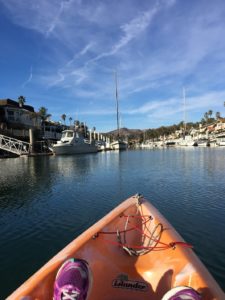
On the day of her brain aneurysm rupture, Tarja was kayaking in Ventura Harbor with her friend Denise Ludwig.
After Michigan, how did you find yourself in Santa Barbara?
That was a long journey. I’ve lived in many parts of this country: Indiana (IU has the largest Finno-ugric language department in all the universities in the U.S.), Illinois, New Hampshire, Massachusetts, and in between I also spent a few more years in Finland.
Back in Finland, I got offered a position with a global high-tech company in Boston. It meant starting over, once again, but this time I knew a lot more about the U.S. I made a very conscious choice that I wanted to experience more. My ex-husband agreed that my 3-year-old son would come with me.
Ten years went by fast in Boston — being an executive woman in the “man’s world;” being a single mom, and learning to trust myself through tough times and good. That all led to starting my own company in 1994 and building it with the intention of affecting positive change through healthcare innovation.
We work across the globe, but have many customers on both coasts of the U.S. So during a big west coast project, I rented an apartment in Ventura, California. One morning, I was staying there and kayaking with a friend, when I had a brain aneurysm rupture. I was immediately transferred from the first hospital in Ventura to the Cottage Hospital in Santa Barbara, and had an emergency 7-hour brain surgery. Of which, I remember absolutely nothing. I nearly died, but after three and a half weeks in the ICU, and several weeks in the hospital, I was ready to start my recovery. That’s also when I made the decision to sell the house in NH, and become a California resident.
And that’s what led you to start dancing, right?
Dance is a big part of the Finnish culture, so I grew up dancing. If you go to Finland, you may not see many people smiling and making nice, but start the music, and we love to dance!
In the summer especially, it’s not uncommon to hear an accordion play and see people singing and dancing — often to traditional Finnish music. But we also have our own version of tango.
The Finnish tango embraces the same melancholy music as Argentine tango, but the steps are different. So, I discovered that California has a big community of Argentine tango dancers. So as I got better and gained a little bit more strength, I wanted to see if I could still dance. Two years ago, I flew to Argentina, after my doctor gave me the green light to travel again.
It was in San Telmo, Buenos Aires, where I fell forever in love with Argentine tango. On arrival, I still had a lot of issues with balance, having had to learn to walk again after brain surgery. I had lost my ability to follow verbal directions, and struggled with short-term memory issues.
I have other disabilities, they’re still minor compared to a lot of people. But losing part of my memory and ability to process things the same way, was really scary.
Learning was going to be hard as a result. That’s part of the reason why I went to Argentina. I had no idea how I was going to learn. I wanted to push myself and challenge my body and my brain to not give up. I also desperately needed to rediscover who I was and what I was still capable of.
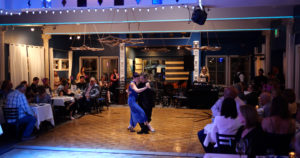
The Harbor of Life event brought together dancers, doctors, and other community supporters from all walks of life.
As a brain aneurysm survivor and a health advocate, have you observed any ways that dancing and the brain directly interconnect?
My goodness, yes, absolutely. We are doing more research right now on this very topic and finding more and more proof of the therapeutic effects of dance and music. For instance, studies with Parkinson’s disease patients who engage in dance therapy, show improved movement and balance; along with better mental well-being.
From an emotional perspective, going back to tango and my own healing… Tango is an invitation to connect. The person who asks you to dance, connects with you first with their eyes, and then through the embrace on the dance floor, you move together. Right then and there, you belong.
I had always been a high achiever and perhaps also a perfectionist. So in my case, learning tango with a broken brain has taught me that I have to accept my disability to conquer it. Because it’s not the disability that keeps me from doing something — it’s the box inside my head where I got stuck. I had lost me. But I am not my disability. It took me a while, but I know this now all the way to my toes!
I let go of the worry that I can’t follow direction, and started to listen to the cues given by the movement of the person leading, and also the music. I allowed my body to follow. Sometimes I watch others, imitating them first, adjusting it to be mine, and then repeating over and over again.
I think my body is now teaching my brain. Memory isn’t just what’s inside our brains: it’s also what’s inside our muscles. Imagine thinking that you can’t learn things anymore. Then all of a sudden discovering that you can! I can learn something that’s really hard and retain it without having to remember what the steps are called, or being able to articulate their particular order. That is pure JOY!
So this emotional and physical healing through dance, is what I want to also make available to more survivors of brain injury. I’ve started a non-profit, Harbor of Life. My instructor from Argentina, a psychologist, and a neurologist, among others are part of the group, helping develop music and local community based programs that can easily be replicated anywhere. With COVID-19, physically dancing together may be on hold, but music and movement does not have to be on hold… So until we get through the pandemic, we are offering a weekly music hour online and building other ways to empower survivors.
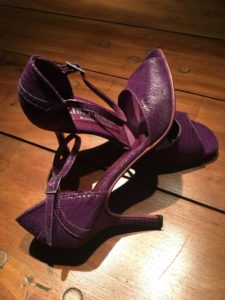
Tarja initially learned the Argentine tango from her instructor in Buenos Aires — Carolina Bonaventura, owner of Maripositas Tango School.
Music itself has a healing effect on the brain, but coupled with movement and dance, it becomes a way to express ourselves and our emotions. No words needed. For me, it is about bringing together the mind, the body, and the soul where for a little while the worries, the pain, and the illness can be put aside in order to make space for connection, hope, and joy.
It’s almost a ritual — in that, the more I repeat it, the more powerful it also becomes in carrying me forward. It’s not just about the physical part of it at all for me. It’s much more.
Do you think it’s important for different performance art forms like dance to migrate around the world?
I think that dance and music, and performance arts in general, have the power to bridge cultures while celebrating differences. This includes using dance to accentuate what’s unique about a national or regional culture, a tribe, or even individual. I love to watch traditional dances of each country I visit, because they tell a story of the people, their temperament and their traditions and values through musical expression.
The story comes through movements that you don’t have to have the words for.
Do you think that’s part of why dance can be universal for people with different cultural, socioeconomic, and political backgrounds — the fact that it’s through movement and not language?
Given that I’m a Finn and we use less verbal language, I will, of course, say yes to that. In some sense, dance is an equalizer that unites us at that basic, most primitive level of humanity.
Even now, as we are in the midst of social distancing… Last weekend, we had a virtual worldwide milonga!
It’s a social tango dance event and normally always in person of course. In Buenos Aires, milongas start maybe at 10 o’clock at night and can go until 4 or 5 in the morning. But no one can go to milongas right now because we cannot be close.
Last weekend there was a five-hour virtual milonga. People from Sweden, Spain, Argentina, the U.S., and elsewhere, all logged on to Zoom. For five hours the best tango DJs were playing music. People were dancing in their living rooms. We were still connecting with one another, as a community of dancers, and human beings: the size of the house you danced in didn’t matter, the language you spoke didn’t matter, your race or color of skin, didn’t matter…
I think dance and movement can also help us experiment and express ourselves in new ways — even when we are not quite ready to put into words what we are feeling. Emotionally, this may be the magic that is at the heart of the healing power of dance to our mental well-being. Expressing our grief or sadness or fears through dance or giving love and hope and joy license to move us is powerful.
Even just watching others dance, we can access some part of that feeling inside of us. It is always a connector.
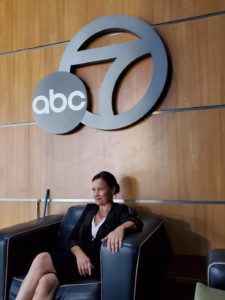
The Harbor of Life event received a lot of publicity, including coverage by ABC News.
Do you feel your experience as a migrant and a world-traveller affected the way that you built your company and how you currently run it?
I’m still a very Finnish woman in many ways, but I am also a world citizen by experience and choice. As a leader, I’ve integrated many Finnish values into how I’ve shaped Action for Results.
To start with, we are, of course, a woman-owned business. I recognize the importance of empowering more women to take charge of their professional and personal lives and be able to build a successful career in the med tech sector that traditionally has been dominated by men. For me, this is not a numbers game. It’s about working with women of all ages — as a coach, a role model — helping them feel empowered to make change happen on whichever scale matters the most, including government.
In Finland, we have a 34-year-old Prime Minister, Sanna Marin, who now leads a coalition of five women in the top government posts. For 12 years, Finland had a woman for a president, Tarja Halonen…
Other things affected by my own migration path… Action for Results values and how we operate, for sure. For instance, we are very clear that despite all of our collective industry expertise, knowledge or skills, we can never know a person or organization better than they know themselves. So our job as consultants is not to tell a company or person what to do. Our job is to gather and present information that they already may know, or have not yet been exposed to, in such a manner that they are able to use it to decide the best course of action for themselves. It’s about being candid and honest, but also respectful of the situation and people at hand. Because so much of our work is about transformation and change, this is so important.
Finally, I would say that I’ve made a very deliberate choice to build cultural competence into our own work and relationship practices, and into our training and coaching offerings. We work across the globe, in pharmaceuticals, medical devices, and medtech companies, building innovation and product delivery capability. But much of our work is about human behavior. You cannot build a cross-cultural innovation team to reach high performance without addressing the richness and the clashes that come along with differences, and giving people the tools and skills to work across cultures, languages, and time zones. Now that most of our customers are working remotely, it’s even more important to pay attention to how we facilitate the right conversations and engagement in virtual working sessions.
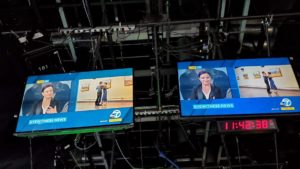
While on the air, Tarja spread information about brain aneurysm signs and symptoms as well as the healing power of dance.
Do you have any thoughts about how migration and the brain interact?
I think it depends on your experience through migration. For the most part, my own experiences have been positive where I’ve been able to work, travel, and live in many parts of the world. But it has been by choice.
Still, I’ve felt at times isolated — truly being a “foreigner,” not knowing how I can belong. I’ve also been told to “go home” a few times. So when people are forced to migrate due to hostile or difficult conditions in their home country, or perhaps they move by choice, but don’t speak the language of their new country, or they become the target of anger and even hatred… Those are hard conditions, which can traumatize a person and, for good reason, cause them to go into a survivor mode. Which of course affects how the brain and the well-being of the person. It’s difficult to find resilience if you’re under constant attack.
But I do believe that people who have a personal experience living abroad and experiencing different cultures, are more likely to be curious, open, and willing to experiment with new things. They are able to look at themselves and others differently as a result: with more kindness, empathy, compassion — and humor! That “box” in our brain expands when we become curious and ask questions to understand rather than judge.
I went to Argentina after brain surgery, asking “who am I” — who is this person that’s left? Tango became a way by which I was able to get the courage to look at myself in the mirror and accept the new me.
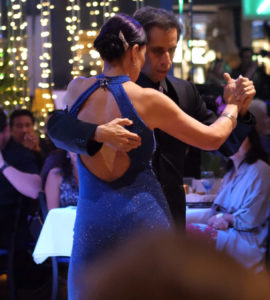
All proceeds from the Harbor of Life event were donated to Tarja’s Lisa Foundation Campaign.
So much of what empowers us and makes us resilient has to do with being able to find some safe place somewhere in the world: on a mountain top, in a dance studio, inside the kitchen, next to a big tree away from the party — where we can be brutally honest but also kind in facing ourselves. Just the way we are. We don’t always get encouragement from the surroundings we’re in, nor the people that we come in touch with. The self reflection is important — doesn’t matter whether you’ve got a broken brain or not. We’re all broken and we’re all wholesome. But it takes courage. No longer do I hide because I make mistakes — let the world watch: it’s a Dance of Life.
It’s a hard journey to go through, but I think it’s a journey well worthwhile.
What is one word that describes your own journey?
If I really had to boil it down to one, after everything: JOY!
Joy of connection.
If it wasn’t for meeting and sharing moments that matter with so many people across the world,
I would never have learned the things that I’ve learned. I wouldn’t be who I am.
impactmania’s past interviews and programs have been featured in international media, a number of universities, the UN, U.S. Consulates, and have been cited by Harvard Business School, Cambridge Scholars Publishing, and Duke University Press. impactmania’s Women of Impact program was awarded the U.S. Embassy Public Diplomacy grant (2019).
